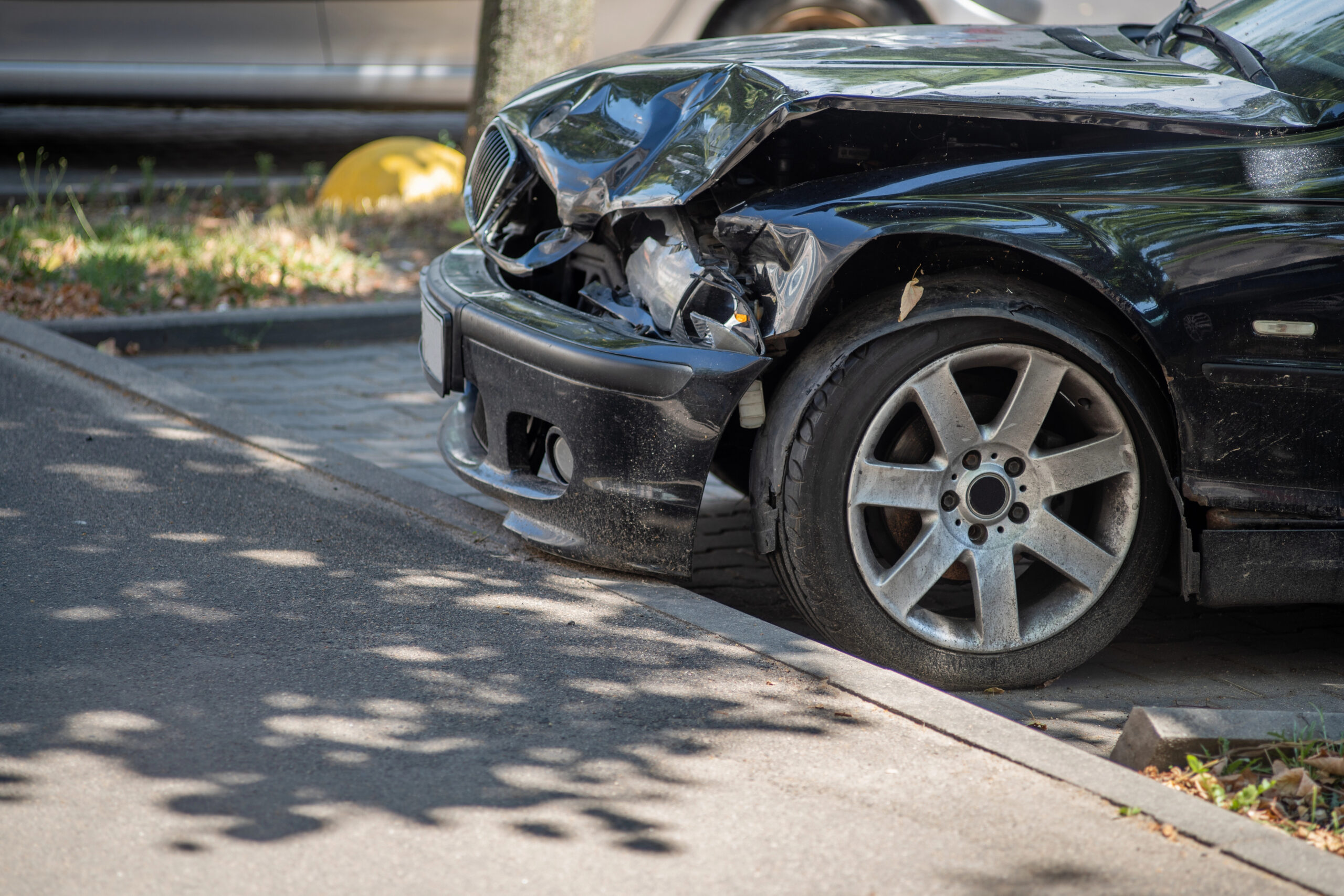If you don’t have car insurance, getting in a car accident can result in serious legal consequences, even if you’re not the at-fault driver. You can still file a claim with the other driver’s insurance company, but depending on your state’s laws, you may not be able to collect certain damages, like compensation for pain and suffering or disfigurement.
Can you still file a claim with the other driver’s insurance if you’re uninsured?
Even if you’re uninsured, you can still file a claim with the at-fault driver’s insurance company following an auto accident. The driver responsible for causing an accident is legally required to pay for crash-related expenses, including lost wages, pain and suffering, and medical bills.
However, in some states, uninsured drivers aren’t eligible for a full settlement due to restrictive “no pay no play” laws.
How to file a claim if you’re an uninsured driver
The process of filing a car insurance claim is very similar for insured and uninsured drivers, except you’ll need to reach out to the other driver’s insurance—a step that would normally be handled by your insurance provider. Contact the other driver’s insurance provider and explain that you need to make a claim. To support your claim, you’ll need as much evidence as you can find. Collect physical or digital copies in a file to send to the insurance provider.
Appropriate evidence to include in a car accident claim includes:
- Basic information about the exact time, location, and circumstances of the accident
- Descriptions of the damages with photos and videos
- A police report
- Dash cam footage
- Eyewitness accounts
- Any medical bills or other relevant documents if you’re filing a personal injury claim
Once you’ve submitted your evidence, wait for the assigned insurance adjuster to perform a case evaluation and determine your payout for any necessary car repairs, property damage, and/or personal injury claims.
If you’re unsatisfied with your settlement offer, you can also hire a personal injury lawyer or car accident attorney to help you. Just remember that after your free consultation, working with a law firm will cost you a portion of your settlement.
At the site of the accident, get the other driver’s name, contact information, insurance provider, driver’s license number, and vehicle information.
If you didn’t do this at the scene of the accident, reach out to the other driver or the police department for the info you need as soon as possible.
How do state laws impact your insurance claims as an uninsured driver?
If your state has a “no pay no play” law and you got into an accident while driving without insurance, your options for compensation will be seriously limited.
These laws still allow you to file a claim if you’re uninsured, but there are restrictions on the amount of compensation you can receive and the type of damages you can seek. The exact restrictions will vary from state to state but generally apply to non-economic damages, like pain and suffering or emotional distress.
Does your state have a “no pay no play” law?
There are currently 11 states with “no pay no play” laws in place.
“No pay no play” laws are not standardized and therefore vary slightly in each state. Here’s a breakdown of the legal restrictions on uninsured drivers in all 11 states.
| State | No pay no play law |
|---|---|
| Alaska | Uninsured drivers may not collect non-economic damages unless the at-fault driver acted recklessly or with intent, was under the influence, or fled the scene. |
| California | Uninsured drivers cannot collect non-economic damages unless the at-fault driver is convicted of driving under the influence. |
| Indiana | Uninsured drivers with prior violations of Indiana’s financial responsibility laws cannot collect non-economic damages. |
| Iowa | Uninsured drivers may not collect non-economic damages if, during the accident, they were committing a felony and were then convicted of that felony. |
| Kansas | Drivers who fail to maintain the minimum level of insurance required by law cannot collect non-economic damages following an accident. |
| Louisiana | Drivers who fail to maintain the minimum level of insurance coverage cannot collect bodily injury damages for the first $15,000 and property damage compensation for the first $25,000. This restriction does not apply if the at-fault driver was under the influence, acted intentionally, or fled the scene of the accident. |
| Michigan | Drivers without the state minimum level of insurance cannot collect damages following an accident, regardless of fault. |
| Missouri | Uninsured drivers cannot pursue claims unless the at-fault driver was under the influence when they caused the accident. |
| New Jersey | Uninsured drivers cannot collect economic or non-economic damages. |
| North Dakota | Uninsured drivers with at least one conviction of driving without insurance cannot collect non-economic damages. |
| Oregon | Uninsured drivers may not collect non-economic damages unless the at-fault driver acted intentionally or recklessly or was committing a felony at the time of the accident. |
No-fault vs at-fault states
Different states have different laws surrounding car accident fault. There are two basic types of state laws surrounding fault:
- In a no-fault state, all drivers involved in an accident will file personal injury claims with their own insurer. If you’re uninsured, some states will limit your ability to collect compensation for injury-related expenses.
- In an at-fault state, also called a full tort state, the driver considered at fault for an accident is financially responsible for paying all damages. This is a much more common legal structure.
How do fault laws affect you as an uninsured driver? If you live in one of the 38 at-fault states in the U.S., you’ll be financially liable for all of the damages you cause in an accident—including expensive personal injury claims. If you’re not at fault, the driver who caused the accident will be responsible for paying your damages.
However, some at-fault states also require drivers to carry uninsured/underinsured motorist coverage (UM/UIM) to pay for personal injury claims following an accident with an uninsured driver. If you live in one of these states, some of those damages might be covered by the other driver’s insurance.
Below are the fault laws in each state, and their UM/UIM requirements.
| State | Uninsured motorist coverage requirements | Fault laws |
|---|---|---|
| Alabama | Optional | At-fault state |
| Alaska | Optional | At-fault state |
| Arizona | Optional | At-fault state |
| Arkansas | Optional | At-fault state |
| California | Optional | At-fault state |
| Colorado | Optional | At-fault state |
| Connecticut | Both required at $25,000 per person/ $50,000 per accident | At-fault state |
| District of Columbia | UM required at $25,000 per person / $50,000 per accident UIM not available | At-fault state |
| Delaware | Optional | At-fault state |
| Florida | Optional | No-fault state |
| Georgia | Optional | At-fault state |
| Hawaii | Optional | No-fault state |
| Idaho | Optional | At-fault state |
| Illinois | Both required at $25,000 per person / $50,000 per accident | At-fault state |
| Indiana | Optional | At-fault state |
| Iowa | Optional | At-fault state |
| Kansas | Both required at $25,000 per person/ $50,000 per accident | No-fault state |
| Kentucky | Optional | No-fault state |
| Louisiana | Optional | At-fault state |
| Maine | Both required at $50,000 per person/ $100,000 per accident | At-fault state |
| Maryland | Both required at $30,000 per person / $60,000 per accident | At-fault state |
| Massachusetts | UM required at $20,000 per person / $40,000 per accident UIM optional | No-fault state |
| Michigan | Optional | No-fault state |
| Minnesota | Both required at $25,000 per person / $50,000 per accident | No-fault state |
| Mississippi | Optional | At-fault state |
| Missouri | UM required at $25,000 per person / $50,000 per accident UIM optional | At-fault state |
| Montana | Optional | At-fault state |
| Nebraska | Both required at $25,000 per person / $50,000 per accident | At-fault state |
| Nevada | Optional | At-fault state |
| New Hampshire | Both required at $25,000 per person / $50,000 per accident | At-fault state |
| New Jersey | Optional | No-fault state |
| New Mexico | Optional | At-fault state |
| New York | UM required at $25,000 per person / $50,000 per accident UIM optional | No-fault state |
| North Carolina | UM required at $30,000 per person / $60,000 per accident UIM required if liability limits exceed state minimum | At-fault state |
| North Dakota | Both required at $25,000 per person / $50,000 per accident | No-fault state |
| Ohio | Optional | At-fault state |
| Oklahoma | Optional | At-fault state |
| Oregon | UM required at $25,000 per person / $50,000 per accident UIM optional | At-fault state |
| Pennsylvania | Optional | No-fault state |
| Rhode Island | Both required if liability limits exceed state minimum | At-fault state |
| South Carolina | UM required at $25,000 per person / $50,000 per accident UIM optional | At-fault state |
| South Dakota | Both required at $25,000 per person / $50,000 per accident | At-fault state |
| Tennessee | Optional | At-fault state |
| Texas | Optional | At-fault state |
| Utah | Optional | No-fault state |
| Vermont | Both required at $50,000 per person / $100,000 per accident | At-fault state |
| Virginia | Both required at $30,000 per person / $60,000 per accident | At-fault state |
| Washington | Optional | At-fault state |
| West Virginia | UM required at $25,000 per person / $50,000 per accident UIM optional | At-fault state |
| Wisconsin | UM required at $25,000 per person / $50,000 per accident UIM optional | At-fault state |
| Wyoming | Optional | Optional |
Check your state’s contributory/comparative negligence laws, too
In many car accidents, fault is shared between both drivers. Even if the other driver holds most of the responsibility for the crash, you may be assigned a portion of the fault depending on the exact circumstances leading up to the accident.
Depending on your state’s contributory/comparative negligence laws, you may be unable to collect damages for medical expenses following an accident, or you may be limited in how much you can claim. Shared fault also means that you’ll be vulnerable to personal injury lawsuits if you’re found to have some responsibility for the accident.
Currently, four states and the District of Columbia use contributory negligence laws. In these states, you may be unable to collect damages for medical expenses and vehicle repairs following an accident at all, or you may be limited in how much you can claim—even if you’re only found partially at fault. Here’s how these laws work in these states:
| State | Contributory negligence law |
|---|---|
| Alabama | Alabama is a pure contributory negligence state. That means you can only collect damages after an accident if you are 0% at fault. |
| Maryland | Maryland has a contributory negligence law stating that drivers are ineligible for compensation following an accident unless they are 0% responsible. |
| North Carolina | Under North Carolina’s contributory negligence law, you are ineligible for compensation following an accident unless you are 0% at fault. |
| Virginia | Under Virginia’s contributory negligence law, drivers are ineligible for compensation after an accident unless they are 0% at fault. |
| District of Columbia | Under the District of Columbia’s contributory negligence law, drivers are ineligible for compensation following an accident unless they are 0% at fault. |
The remaining states use comparative negligence laws or modified-comparative negligence laws. These laws split the blame (and damages) between both parties involved in an accident based on their respective levels of fault.
If you’re declared partially at fault in one of these states, you’ll still be financially responsible for your portion of the fault, but you’ll also be able to pursue compensation for damages depending on your percentage of fault.
Here are the comparative negligence laws in the remaining 46 states.
| State | Comparative negligence law |
|---|---|
| Alaska | Alaska is a pure comparative negligence state, meaning you can collect damages after an accident unless you are found to be 100% at fault. |
| Arizona | Arizona is a pure comparative negligence state, which means you can seek damages following an accident unless you are 100% at fault. |
| Arkansas | Arkansas is a modified-comparative negligence state. That means that you can collect compensation after an accident unless you are 50% or more at fault. |
| California | California is a pure comparative negligence state, meaning you can collect compensation after an accident unless you are 100% at fault. |
| Colorado | Colorado is a modified-comparative negligence state, meaning that as long as you’re 49% or less at fault, you can collect damages after an accident. |
| Connecticut | Connecticut uses 51% modified-comparative negligence laws. That means that you can collect compensation as long as you’re less than 51% at fault. |
| Delaware | Delaware is a 51% modified-comparative negligence state. You can collect compensation following an accident as long as you were less than 51% at fault. |
| Florida | Florida recently switched to a comparative negligence model, meaning that you can collect damages if you are less than 51% at fault. |
| Georgia | Georgia is a modified-comparative negligence state, meaning you can collect damages as long as you’re 49% or less at fault. |
| Hawaii | Hawaii has a 51% comparative negligence law, meaning you can seek compensation after an accident as long as you are less than 51% at fault. |
| Idaho | Idaho uses modified-comparative negligence laws. That means you can collect damages after an accident as long as you are 49% or less at fault. |
| Illinois | Illinois follows a 51% modified-comparative negligence law, meaning that you can collect compensation for losses following an accident if you are less than 51% at fault. |
| Indiana | Indiana has a 51% modified-comparative negligence law, which states that you’re entitled to compensation following an accident if you’re less than 51% at fault. |
| Iowa | Iowa uses a 51% modified-comparative negligence law, meaning Iowa drivers are entitled to damages after an accident if they’re less than 51% at fault. |
| Kansas | Kansas has a modified-comparative negligence law stating that Kansas drivers are entitled to compensation after an accident if they are less than 50% at fault. |
| Kentucky | Kentucky has a pure comparative negligence law that says Kentucky drivers can collect compensation after an accident if they are less than 100% at fault. |
| Louisiana | Under Louisiana’s pure comparative negligence law, drivers are eligible for compensation following an accident if they are less than 100% at fault. |
| Maine | Maine has a modified-comparative negligence law that says drivers are eligible for compensation after an accident if they are 49% or less at fault. |
| Massachusetts | Under Massachusetts’ 51% modified-comparative negligence law, drivers can collect damages following an accident if they are found less than 51% at fault. |
| Michigan | Michigan follows a 51% modified-comparative negligence law, meaning that drivers can collect damages if they are 50% or less at fault. |
| Minnesota | Minnesota has a 51% modified-comparative negligence law stating that drivers are entitled to compensation after an accident if they are 50% or less at fault. |
| Mississippi | Under Mississippi’s pure comparative negligence law, drivers are eligible to collect damages if they are less than 100% at fault. |
| Missouri | Missouri has a pure comparative negligence law, meaning drivers can collect damages after an accident if they are less than 100% at fault. |
| Montana | Montana follows a 51% modified-comparative negligence law, which means that drivers are eligible for compensation after an accident if they are 50% or less at fault. |
| Nebraska | Under Nebraska’s modified-comparative negligence law, drivers are eligible to collect damages following an accident if they are less than 50% at fault. |
| Nevada | Nevada’s 51% modified-comparative negligence law states that drivers can collect damages if they are less than 51% at fault. |
| New Hampshire | Under New Hampshire’s 51% modified-comparative negligence law, drivers are eligible to collect damages after an accident if they are less than 51% at fault. |
| New Jersey | New Jersey follows a 51% modified-comparative negligence law, meaning you can seek damages after an accident if you are less than 51% at fault. |
| New Mexico | Under New Mexico’s pure comparative negligence law, drivers can collect damages after an accident unless they are 100% at fault. |
| New York | New York is a pure comparative negligence state, meaning you are eligible for compensation after an accident unless you are 100% at fault. |
| North Dakota | Under North Dakota’s modified-comparative negligence law, you can collect damages following an accident if you are less than 50% at fault. |
| Ohio | Ohio follows a 51% modified-comparative negligence law, meaning you’re eligible for compensation after an accident if you are less than 51% at fault. |
| Oklahoma | Under Oklahoma’s 51% modified-comparative negligence law, drivers are eligible for compensation after an accident if they are less than 51% at fault. |
| Oregon | Oregon follows a 51% modified-comparative negligence law stating that drivers can collect damages after an accident if they are less than 51% at fault. |
| Pennsylvania | Pennsylvania has a 51% modified-comparative negligence law, meaning drivers can collect compensation following an accident if they are less than 51% at fault. |
| Rhode Island | Under Rhode Island’s pure comparative negligence law, drivers are eligible for compensation following an accident unless they are 100% at fault. |
| South Carolina | South Carolina follows a 51% modified-comparative negligence law stating that drivers can collect damages after an accident if they are less than 51% at fault. |
| South Dakota | South Dakota follows a slight-gross negligence comparative law stating that drivers can only collect damages after an accident if one party displayed “slight” negligence while the other party displayed “gross” negligence. |
| Tennessee | Under Tennessee’s modified-comparative negligence law, drivers are eligible for compensation after an accident if they are less than 50% at fault. |
| Texas | Texas follows a 51% modified-comparative negligence law stating that you are eligible for compensation after an accident if you are less than 51% at fault. |
| Utah | Utah has a modified-comparative negligence law, meaning drivers can collect damages after an accident if they are less than 50% at fault. |
| Vermont | Vermont has a 51% modified-comparative negligence law, meaning that you are eligible for compensation after an accident if you are less than 51% at fault. |
| Washington | Under Washington’s pure comparative negligence law, you can collect damages after an accident unless you are 100% at fault. |
| West Virginia | West Virginia follows a 51% modified-comparative negligence law, meaning that drivers can collect damages following an accident if they are less than 51% at fault. |
| Wisconsin | Wisconsin has a 51% modified-comparative negligence law that allows drivers to collect compensation after an accident if they are less than 51% at fault. |
| Wyoming | Under Wyoming’s 51% modified-comparative negligence law, drivers are eligible for compensation after an accident if they are less than 51% at fault. |
Even if you’re not at fault, there are legal consequences for driving uninsured
In every state except New Hampshire, you’re required to carry an insurance policy that includes liability insurance. As such, getting caught driving without insurance has serious legal consequences.
The exact consequences for driving without insurance vary from one state to the next, but they may include:
- Jail time
- License suspension
- Heavy fines
- Suspended vehicle registration/license plates
- High insurance reinstatement fees
If you operate a motor vehicle without insurance, your legal options are slim. If this is your first offense, you may face lighter fines and less severe consequences. But if you’re caught driving without insurance, you’ll pay much higher rates when you do buy a new policy—drivers who have had a lapse see their rates rise to an average of $248 a month—72% more than the national average of $144 a month.
What if you don’t have car insurance, but the vehicle owner does?
If the vehicle owner has car insurance and you’re not listed on their policy, you may still be covered under permissive use. Permissive use assumes that the owner of the car allowed you to use their vehicle. It won’t apply to vehicles that you borrow or drive regularly, but it will apply if you’re using a friend’s car as a one-time favor.
If you get into an accident in a friend’s car, you’ll be covered under their insurance and should provide their insurance information if asked. Regardless, assuming you’re an at-fault party, you’ll still be financially responsible for any damages beyond your friend’s coverage limits. Any accident claim made against you will also be made via your friend’s insurance, which may cause an increase in your friend’s rates.
How to find affordable auto insurance after a lapse in coverage
After you’re caught driving uninsured, your best course of action is to get a new policy as soon as possible. Driving without insurance is illegal, and you’ll get into even more legal trouble if you get caught behind the wheel without coverage a second time.
Rates are significantly higher for drivers who have experienced a lapse in coverage, especially after a car accident, but there are a few things you can do to combat this:
- Shop around with multiple providers: The best way to find affordable rates after an insurance lapse is by gathering quotes from several different providers. You can do this on your own, or let Jerry simplify the shopping process for you.
- Look for discounts: Most insurance providers offer car insurance discounts of one kind or another, even if they’re not directly advertised. Call your provider or use Jerry’s discount tool to learn more about your options.
- Bundle your home and auto policies: You’ll usually get a discounted rate for purchasing multiple policies from the same provider and bundling your coverage.
- Take a defensive driving course: Many insurance providers offer discounts to drivers who take a defensive driving class. If you take one of these due to a court mandate, however, it won’t count toward a discount.
FAQ
-
Should you hire a lawyer if an uninsured driver hits you?
-
What does uninsured motorist coverage cover?
-
What happens if you’re uninsured but you’re the victim of a hit-and-run?

Liz Jenson is an insurance writer who specializes in general automotive and insurance topics. Liz’s mission is to produce informative and useful content to help car owners make smart choices when buying cars and car insurance. Since joining Jerry in 2021, Liz has written nearly 4,000 long- and short-form articles on topics including state-specific insurance recommendations, common car insurance questions, and deep dives into vehicle model details. Before they came to Jerry, Liz was a full-time student at Indiana University, Bloomington working on a double major in English and French.

Expert insurance writer and editor Amy Bobinger specializes in car repair, car maintenance, and car insurance. Amy is passionate about creating content that helps consumers navigate challenges related to car ownership and achieve financial success in areas relating to cars. Amy has over 10 years of writing and editing experience. After several years as a freelance writer, Amy spent four years as an editing fellow at WikiHow, where she co-authored over 600 articles on topics including car maintenance and home ownership. Since joining Jerry’s editorial team in 2022, Amy has edited over 2,500 articles on car insurance, state driving laws, and car repair and maintenance.








